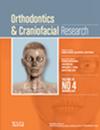Tooth movement analysis of maxillary dentition distalization using clear aligners with buccal and palatal mini-screw anchorages: A finite element study
Abstract
Objective
To assess the tooth movement trends during the three stages of maxillary dentition distalization with clear aligners (CA) and to compare the efficacy of different mini-screw anchorage systems.
Materials and Methods
Three-dimensional (3D) finite element models of three anchorage systems (A, control group; B, buccal mini-screw anchorage group; C, palatal mini-screw anchorage group) were established. Three stages of simulating maxillary dentition distalization with CA included maxillary molar distalization (stage 1), maxillary premolar distalization (stage 2) and maxillary anterior teeth retraction (stage 3). Therefore, a total of nine models were constructed to analyse the 3D displacement of maxillary teeth during the distalization process.
Results
The displacement pattern of maxillary dentition during distalization was similar across the three groups, but with varying magnitudes. During stage 1, groups B and C exhibited greater amounts of molar distalization compared to group A. Group C also demonstrated the least amount of labial movement of the maxillary central incisor compared to the other two groups. During stage 2, the mesial displacement of the maxillary first molar was less significant in groups B and C than in group A. In the final stage, group C exhibited a greater amount of maxillary anterior retraction compared to groups A and B.
Conclusion
The palatal mini-screw anchorage system was effective in reducing anchorage loss and improving the efficacy of maxillary dentition distalization with CA.

 求助内容:
求助内容: 应助结果提醒方式:
应助结果提醒方式:


